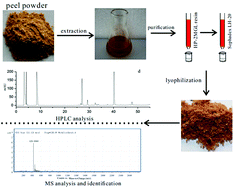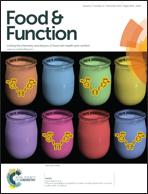Separation and characterization of polyphenolics from underutilized byproducts of fruit production (Choerospondias axillaris peels): inhibitory activity of proanthocyanidins against glycolysis enzymes†
Abstract
Bioactive proanthocyanidins were isolated from the peel of Choerospondias axillaris fruit, which is a waste product of the food processing industry. Compositional analysis indicated that the proanthocyanidins had extension units mainly consisting of epicatechin gallate or epicatechin, and terminal units mainly consisting of catechin. Numerous polymeric forms of the molecules were detected, including monomers, dimers, and trimers. Certain fractions exhibited strong α-amylase or α-glucosidase inhibition in a dose-dependent manner. Furthermore, their inhibitory activities depended on their degree of polymerization and galloylation. For example, the most bioactive fraction had α-amylase and α-glucosidase inhibitory activities (IC50 values) of 541 and 3.1 μg mL−1, respectively. This study demonstrates that proanthocyanidins from C. axillaris peels can inhibit carbohydrate digestive enzymes in vitro and may therefore serve as antidiabetic ingredients in functional or medical foods.


 Please wait while we load your content...
Please wait while we load your content...